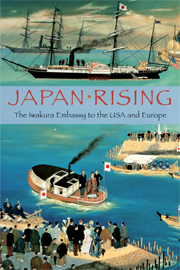Book contents
- Frontmatter
- Contents
- Introduction by Ian Nish
- Note on the Text
- VOLUME I THE UNITED STATES OF AMERICA
- VOLUME II BRITAIN
- VOLUME III CONTINENTAL EUROPE, 1
- VOLUME IV CONTINENTAL EUROPE, 2
- VOLUME V CONTINENTAL EUROPE, 3; AND THE VOYAGE HOME
- 82 The Vienna Universal Exposition, 1
- 83 The Vienna Universal Exposition, 2
- 84 A Record of Switzerland
- 85 Switzerland's Mountain Scenery
- 86 A Record of Berne and Geneva
- 87 A Record of Lyons and Marseilles
- 88 Spain and Portugal
- 89 Political Practices and Customs in Europe
- 90 European Geography and Transportation
- 91 The Climate and Agriculture of Europe
- 92 European Industry
- 93 European Commercial Enterprise
- 94 The Voyage Through the Mediterranean
- 95 The Voyage Through the Red Sea
- 96 The Voyage Through the Arabian Sea
- 97 A Record of the Island of Ceylon
- 98 The Voyage Through the Bay of Bengal
- 99 The Voyage Through the China Sea
- 100 A Record of Hong Kong and Shanghai
- Index
92 - European Industry
Published online by Cambridge University Press: 04 August 2010
- Frontmatter
- Contents
- Introduction by Ian Nish
- Note on the Text
- VOLUME I THE UNITED STATES OF AMERICA
- VOLUME II BRITAIN
- VOLUME III CONTINENTAL EUROPE, 1
- VOLUME IV CONTINENTAL EUROPE, 2
- VOLUME V CONTINENTAL EUROPE, 3; AND THE VOYAGE HOME
- 82 The Vienna Universal Exposition, 1
- 83 The Vienna Universal Exposition, 2
- 84 A Record of Switzerland
- 85 Switzerland's Mountain Scenery
- 86 A Record of Berne and Geneva
- 87 A Record of Lyons and Marseilles
- 88 Spain and Portugal
- 89 Political Practices and Customs in Europe
- 90 European Geography and Transportation
- 91 The Climate and Agriculture of Europe
- 92 European Industry
- 93 European Commercial Enterprise
- 94 The Voyage Through the Mediterranean
- 95 The Voyage Through the Red Sea
- 96 The Voyage Through the Arabian Sea
- 97 A Record of the Island of Ceylon
- 98 The Voyage Through the Bay of Bengal
- 99 The Voyage Through the China Sea
- 100 A Record of Hong Kong and Shanghai
- Index
Summary
The soil of the European continent is not naturally fertile, so people do not depend on farming alone. Although they supplement crops by raising livestock, they are still not able to make a sufficient livelihood. They have therefore become an acquisitive race, searching for what lies under the earth and mining it. Of all the minerals, the one with the richest benefits is coal. Huge deposits of coal lie in the earth, and there is no country in Europe, large or small, which does not produce at least a small amount. (Holland and Denmark produced extremely small quantities.) It is a cheap fuel and generates three times as much heat as wood.
The mineral second to coal in its benefits and used in conjunction with it is iron-ore. So great is its usefulness that in Europe the amount of iron-ore consumed came to be a measure of a country's level of development. Every type of manufacturing depends upon iron, and in Europe machinery is used on a huge scale. The country which dominates the iron industry is Britain. America ranks second in production, and Germany is the main producer in continental Europe.
The contribution of coal and iron in increasing a country's productive capacity and assisting manufacturing is immense. Of such industries, spinning and weaving are the most important. In terms of value, silk fabrics command the highest prices, but in terms of the quantity produced cotton comes first.
- Type
- Chapter
- Information
- Japan RisingThe Iwakura Embassy to the USA and Europe, pp. 477 - 481Publisher: Cambridge University PressPrint publication year: 2009



